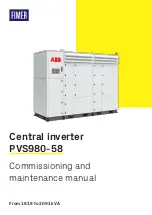
Chapter 2: Installation
48
Powering On and Cabling the Media Converter
After installing the media converter on a desk or wall, next step is to power
on and cable the media converter.
Cabling
Guidelines
Observe the following guidelines when connecting twisted-pair and
fiber-optic cables to the ports on the media converter:
The connector on the cable should fit snugly into the port on the
media converter. The tab on the connector should lock the
connector into place.
Because the twisted-pair port has Auto MDI/MDI-X, you may use
straight-through twisted-pair cable to connect any type of network
device to that port.
For the fiber optic cables, refer to the cable manufacturer
specification for the minimum bend radius.
Applying Power
and Connecting
the Network
Cables
To apply power to the media converter and connect the network cables,
perform the following steps:
1. Attach the smaller end of the USB cable to the USB port labeled 5VDC
on the back panel of the media converter.
2. Secure the USB cable to the media converter using one of the cable
ties (included with the separately purchased wall-mount bracket) as
described below and shown in Figure 32 on page 49:
a. Insert the cable tie through the integral notch on the mounting
bracket adjacent to the USB port.
b. Route the cable next to the cable tie.
Note
Do not exceed the minimum bend radius of your fiber optic cable.
See the manufacturer specifications for the minimum bend radius of
your cable.
c. Loop the cable tie around the cable.
d. Fasten the cable tie.
Summary of Contents for AT-DMC100/LC
Page 8: ...List of Figures 8 ...
Page 10: ...List of Tables 10 ...
Page 14: ...14 ...
Page 34: ...Chapter 1 Overview 34 ...
Page 56: ...Chapter 3 Troubleshooting 56 ...
















































